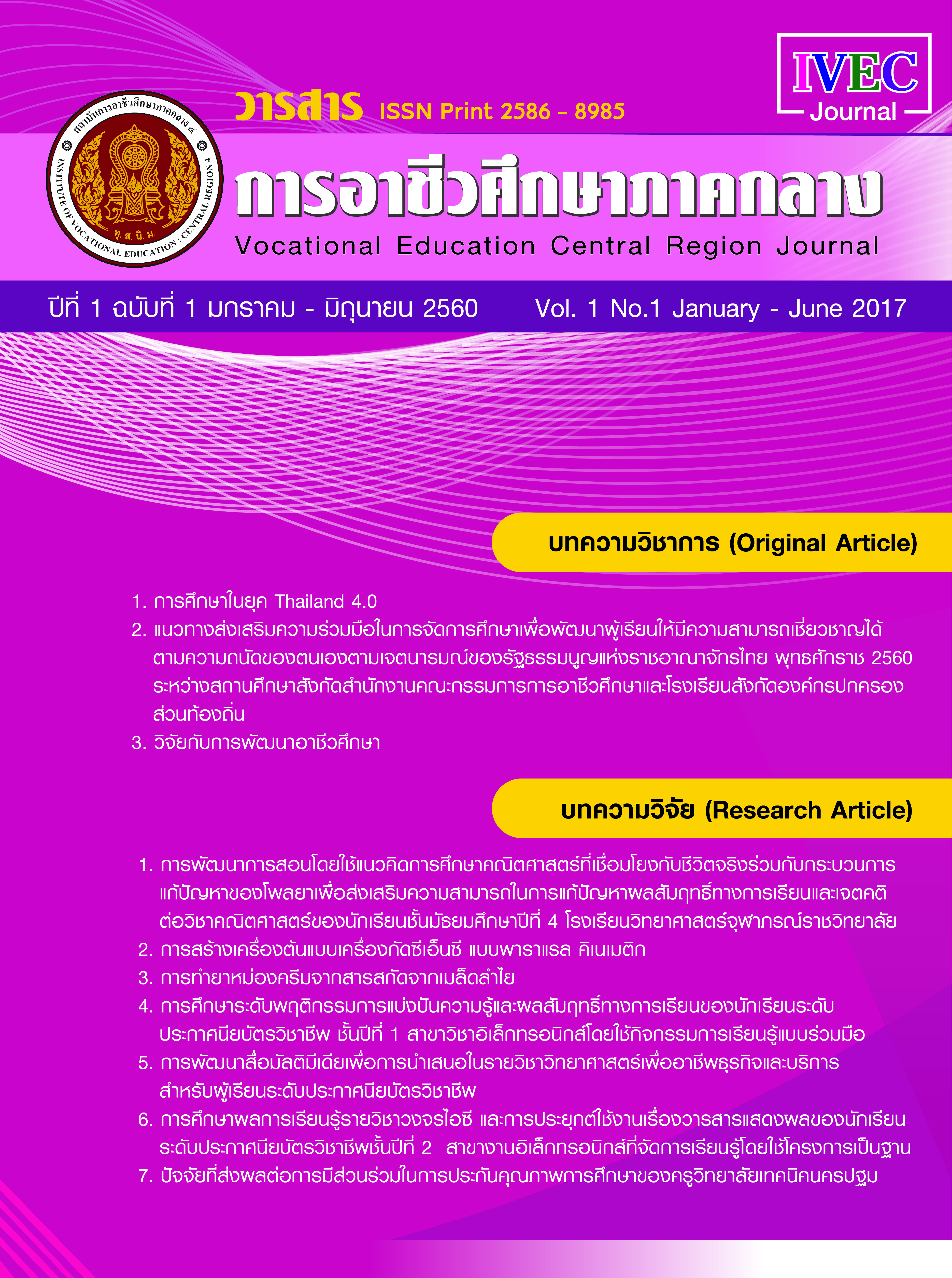Development Of An Instructional Model Based On Using Realistic Mathematics Education Approach And Problem Solving To Enhance Mathematical Skills And Processes In Problem Solving, Achievement And Attitude Of Tenth Grade Students In Princess Chulabhorn’s College Loei
Main Article Content
Abstract
The aims of this research were to develop an instructional model and studythe instructional model based on realistic mathematics education approach that was connected to real life with Polya teaching method for supporting the achievement andattitude in mathematics. This research was composed of two procedures. Step one was developed the instructional model and step two was experimented using the model in classroom instruction. The samples were 24 Mattayomsuksa 4 students at Princess Chulabhorn Science High School. They divided into 2 groups, control group and experiment group. The experimented was carried out for 18 hours. The instruments of this research were a problem solving ability test, achievement test, students’attitude towards mathematics inventory, and a behavior-in-classroom observation form. The data were analyzed by mixed method using average, standard deviation and t- test.
The results of the research were as follow: 1) the developed instruction model consisted of 5 steps 2) the students’ abilities for problem solving after using instruction model of the experiment group was significantly higher 0.05 significant level and higher than control group at 0.05 significant level and 3) the experiment group connected and took their capabilities to solve the problem that was related to real life situations.
Article Details
|
บทความ ข้อมูล เนื้อหา รูปภาพ ฯลฯ ที่ได้รับการตีพิมพ์ในวารสาร การอาชีวศึกษาภาคกลาง ถือเป็นลิขสิทธิ์ของวารสารการอาชีวศึกษาภาคกลางหากบุคคลหรือหน่วยงานใดต้องการนำทั้งหมดหรือส่วนใดส่วนหนึ่ง ไปเผยแพร่ต่อหรือเพื่อกระทำการใด ๆ กองบรรณาธิการไม่สงวนสิทธิ์ ในการคัดลอกบทความเพื่อการศึกษาแต่ให้อ้างอิงแหล่งที่มาให้ครบถ้วน สมบูรณ์ สงวนสิทธิ์ โดย สถาบันการอาชีวศึกษาภาคกลาง 4 ที่ตั้ง 90 ถนนเทศา ตำบลพระปฐมเจดีย์ อำเภอเมือง จังหวัดนครปฐม โทรศัพท์ 034 242 856 , โทรสาร 034 242 858 ISSN : 3056-9176 (print) ISSN : 2985-2382 (online) |
References
กิตติ พัฒนตระกูลสุข. (2546). การเรียนการสอน คณิตศาสตร์ในระดับมัธยมศึกษาของประเทศไทยล้มเหลวจริงหรือ.ว.คณิตศาสตร์. 46(530 – 532) : 54 - 58.
คณะกรรมการพัฒนาการเศรษฐกิจและสังคมแห่งชาติ. (2554). แผนพัฒนาเศรษฐกิจและสังคมแห่งชาติฉบับที่ 11. กรุงเทพฯ: สำนักงานคณะกรรมการพัฒนาการเศรษฐกิจและสังคมแห่งชาติ.
โครงการ PISA ประเทศไทย สถาบันส่งเสริมการสอนวิทยาศาสตร์และเทคโนโลยี. (2557). ผลการประเมิน PISA 2012 คณิตศาสตร์การอ่านและวิทยาศาสตร์นักเรียนรู้อะไร และทำอะไรได้บ้าง. กรุงเทพฯ: อรุณการพิมพ์.
จรรยา ภูอุดม. (2544). การพัฒนารูปแบบการเรียนการสอนที่เน้นผู้เรียนเป็นผู้สร้างความรู้. ปริญญานิพนธ์การศึกษา ดุษฎีบัณฑิต สาขาคณิตศาสตร์ศึกษา มหาวิทยาลัยศรีนครินทรวิโรฒ.
จรรยา ภูอุดม. (2545). แนวทางการจัดการเรียนการสอนและการประเมินผลที่สอดคล้องกับสาระที่ 6 ทักษะ/กระบวนการทางคณิตศาสตร์. ว.คณิตศาสตร์. 46 (524-526): 23-24.
สถาบันทดสอบทางการศึกษาแห่งชาติ. (2557). รายงานการวิเคราะห์คะแนนและคุณภาพของแบบทดสอบทางการศึกษา. ม.ป.ท.: ม.ป.พ.
สมวงษ์ แปลงประสบโชค, สมเดช บุญประจักษ์, และ จรรยา ภูอุดม. (2551). ผลสำรวจสาเหตุนักเรียนไทยอ่อนคณิตศาสตร์และแนวทางแก้ไข. ว.คณิตศาสตร์. 53(599-601): 20-28.
Clyde, C. G. (1967). Teaching mathematics in the elementary school. New York: Ronald Press.
Dickinson, P., Eade, F., Gough, S. and Hough, S. (2010). UsingRealistic Mathematics Education with to Middle Attaining Pupils in secondary schools. In Proceedings of the British Congress for Mathematics Education. (2010). (ed. Joubert, M. and Andrews, P.) Manchester: UK - University Place.
Doorman, M., Drijvers, P., Dekker, T., Van den Heuvel-Panhuizen, M. De Lange, J., and Wijers, M. (2007). Problem Solving as a Challenge for Mathematics Education in The Netherlands. J.ZDM MathematicsEducation. 39 (5-6) : 405-418.
National Council of Teachers of Mathematics. (1980). An agenda for action. Reston: VA:NCTM.


